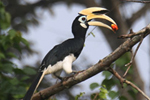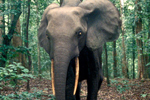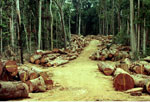Unsustainable hunting of forest elephants, gorillas, forest antelopes, and other seed-dispersers could have long-term impacts on the health and resilience of Congo Basin rainforests, warns a study published today in a special issue of the journal Philosophical Transactions of The Royal Society B.
Conducting a review of more than 160 papers and reports on trends in wildlife populations, hunting, and land use in the Congo Basin, a team of researchers from Oxford University, the University of Queensland, the University of Stirling, and the Wildlife Conservation Society conclude that unless effective management plans are put into place, hunting pressure in the region is likely to increase, with knock-on ecological effects.
The authors warn that “profound ecological changes initiated by hunting … may even exacerbate the predicted effects of climate change for the region.”
While humans have long hunted animals in Africa’s tropical forests, in recent decades the proliferation of logging roads, which provide access to remote forest areas, and the emergence of large urban markets for bushmeat have culminated in a sharp rise in commercial hunting in the region. Exploding demand for ivory is worsening the situation, resulting in depletion of a range of seed-dispersing species and wildlife that plays a key role in forest ecology. For example, the loss of elephants from forests in West Africa has triggered a shift toward smaller, faster-growing trees that are less diverse and store less carbon.
“Animal-dispersed tree species, particularly those with large seeds dispersed by large mammals, therefore contribute a high proportion of the overall carbon-storage capacity of tropical forests,” the authors write. “Carbon storage may therefore erode over time if tree regeneration is hampered by changes in faunal guilds, including extinction of large specialized disperser species or increases in seed-predating species enjoying ecological release from their predators.”
These forests may be less resilient to the effects of climate change, including increases in the incidence of drought and fire.
“Even the slight drying associated with higher temperatures, rainfall changes and increased human incursion predicted for this region may make forests more vulnerable to fire in the future,” the authors write. “Forest resilience has been used to mean the resistance of the vegetation to change; however, ecological function in even a seemingly ‘resilient’ forest may be significantly affected by the relatively small increases in temperature predicted.”
“Severe ecological changes below the forest canopy, driven by hunting, are already occurring,” said co-author Dr. Lauren Coad of the University of Queensland and the University of Oxford in a statement. “The removal of seed-dispersing megafauna such as elephants and apes could reduce the ability of forests to sequester carbon.”

The authors note that while deforestation has declined in the region over the past decade relative to the 1990s, degradation, road-building, and forest conversion is poised to increase with rising investment in oil palm plantations, rubber estates, and sugar cane fields as well as potential expansion of industrial logging and mining operations.
“Logging infrastructure and industrial roads usher in a domino effect of factors known to intensify hunting pressure, such as population growth from an immigrant workforce, increased income and demand for wild meat, increased forest access and increased extraction to international markets for specialist products like ivory,” they write. “Although logging itself can affect animal densities by modifying habitat at landscape and local scales, evidence across the region indicates that secondary impacts of logging activity are currently of far greater ecological importance.”
Given the risk that hunting pressure, and its associated ecological impacts, could increase, the researchers conclude with a call for better planning in the region.
“If future Central African human and wildlife communities are to rely on the range of ecosystem services currently provided by their rainforests—and if the value of these global goods is to be maintained—immediate management of hunting and integration of good hunting practices into large-scale land-use planning must be considered an urgent priority for rainforest preservation and thus an integral and important part of planning for climate change management and mitigation.”
CITATION: Abernethy KA, Coad L, Taylor G, Lee ME, Maisels F. 2013 Extent and ecological consequences of hunting in Central African rainforests in the twenty-first century. Phil Trans R Soc B 368: 20120303. http://dx.doi.org/10.1098/rstb.2012.0303
Related articles
Deforestation rate falls in Congo Basin countries

(07/22/2013) Deforestation has fallen in Congo Basin countries over the past decade despite a sharp increase in the rate of forest clearing in the Democratic Republic of the Congo, according to a new study published in the Philosophical Transactions of the Royal Society B as part of a set of 18 papers on the region’s tropical forests. The special issue, which was put together by Oxford University’s Yadvinder Malhi, covers a range of issues relating to the rainforests of the Congo Basin, including deforestation, the impacts of global change, the history and key characteristics of the region’s forests, and resource extraction, among others.
An insidious threat to tropical forests: over-hunting endangers tree species in Asia and Africa

(04/04/2013) A fruit falls to the floor in a rainforest. It waits. And waits. Inside the fruit is a seed, and like most seeds in tropical forests, this one needs an animal—a good-sized animal—to move it to a new place where it can germinate and grow. But it may be waiting in vain. Hunting and poaching has decimated many mammal and bird populations across the tropics, and according to two new studies the loss of these important seed-disperser are imperiling the very nature of rainforests.
Seeing the forest through the elephants: slaughtered elephants taking rainforest trees with them

(03/11/2013) Elephants are vanishing. The booming illegal ivory trade is decimating the world’s largest land animal, but no place has been harder hit than the Congo basin and its forest elephants (Loxodonta cyclotis). The numbers are staggering: a single park in Gabon, Minkebe National Park, has seen 11,100 forest elephants killed in the last eight years; Okapi Faunal Reserve in the Democratic Republic of the Congo has lost 75 percent of its elephants in fifteen years; and a new study in PLoS ONE estimates that in total 60 percent of the world’s forest elephants have been killed in the last decade alone. But what does that mean for the Congo forest?
62% of all Africa’s forest elephants killed in 10 years (warning: graphic images)
(03/04/2013) More than 60 percent of Africa’s forest elephants have been killed in the past decade due to the ivory trade, reports a new study published in the online journal PLOS ONE. The study warns that the diminutive elephant species — genetically distinct from the better-known savanna elephant — is rapidly heading toward extinction.
Over 11,000 elephants killed by poachers in a single park [warning: graphic photo]
(02/06/2013) Surveys in Gabon’s Minkebe National Park have revealed rare and hard data on the scale of the illegal ivory trade over the last eight years: 11,100 forest elephants have been slaughtered for their tusks in this remote protected area since 2004. In all, poachers have cut down the park’s elephant population by two-thirds, decimating what was once believed to be the largest forest elephant population in the world.
Religion, Chinese government drive global elephant slaughter

(01/24/2013) By some estimates, more than 30,000 elephants were slaughtered across the savannas and forests of Africa and Asia for the ivory trade during 2012. The carnage represents as much as 4 percent of the world’s elephant population. Accordingly, some conservationists are warning that elephants face imminent extinction in some of their range countries. While the plight of elephants is increasingly visible due to media coverage, less widely understood is the role religion plays in driving the ivory trade. This issue was explored at length in an explosive cover story published in National Geographic by Bryan Christy last October. The story, titled Blood Ivory, detailed how demand for religious trinkets is driving large-scale killing of Earth’s largest land animal.
‘The ivory trade is like drug trafficking’ (warning graphic images)

(11/05/2012) For the past five years, Spanish biologist Luis Arranz has been the director of Garamba National Park, in the Democratic Republic of Congo (DRC). Arranz and a team of nearly 240 people, 140 guards among them, work to protect a vast area of about 5,000 square kilometers (1,930 square miles) of virgin forest, home to a population of more than 2.300 elephants that are facing a new and more powerful enemy. The guards are encountering not only bigger groups of poachers, but with ever more sophisticated weapons. According to Arranz, armed groups such as the Lord’s Resistance Army from Uganda are now killing elephants for their ivory.
Forest elephant populations cut in half in protected area
(11/14/2011) Warfare and poaching have decimated forest elephant populations across their range with even elephants in remote protected areas cut down finds a new study in PLoS ONE. Surveying forest elephant populations in the Okapi Faunal Reserve in the Democratic Republic of Congo, researchers have found that the population has fallen by half—from 6,439 to 3,288—over the past decade in the park.
Elephants: the gardeners of Asia’s and Africa’s forests

(04/25/2011) It seems difficult to imagine elephants delicately tending a garden, but these pachyderms may well be the world’s weightiest horticulturalist. Elephants both in Asia and Africa eat abundant amounts of fruit when available; seeds pass through their guts, and after expelled—sometimes tens of miles down the trail—sprouts a new plant if conditions are right. This process is known by ecologists as ‘seed dispersal’, and scientists have long studied the ‘gardening’ capacities of monkeys, birds, bats, and rodents. Recently, however, researchers have begun to document the seed dispersal capacity of the world’s largest land animal, the elephant, proving that this species may be among the world’s most important tropical gardeners.
(03/07/2010) There are few areas of research in tropical biology more exciting and more important than seed dispersal. Seed dispersal—the process by which seeds are spread from parent trees to new sprouting ground—underpins the ecology of forests worldwide. In temperate forests, seeds are often spread by wind and water, though sometimes by animals such as squirrels and birds. But in the tropics the emphasis is far heavier on the latter, as Dr. Pierre-Michel Forget explains to mongabay.com. “[In rainforests] a majority of plants, trees, lianas, epiphytes, and herbs, are dispersed by fruit-eating animals. […] As seed size varies from tiny seeds less than one millimetres to several centimetres in length or diameter, then, a variety of animals is required to disperse such a continuum and variety of seed size, the smaller being transported by ants and dung beetles, the larger swallowed by cassowary, tapir and elephant, for instance.”
Hunting across Southeast Asia weakens forests’ survival, An interview with Richard Corlett

(11/08/2009) A large flying fox eats a fruit ingesting its seeds. Flying over the tropical forests it eventually deposits the seeds at the base of another tree far from the first. One of these seeds takes root, sprouts, and in thirty years time a new tree waits for another flying fox to spread its speed. In the Southeast Asian tropics an astounding 80 percent of seeds are spread not by wind, but by animals: birds, bats, rodents, even elephants. But in a region where animals of all shapes and sizes are being wiped out by uncontrolled hunting and poaching—what will the forests of the future look like? This is the question that has long occupied Richard Corlett, professor of biological science at the National University of Singapore.
Illegal ivory demand could wipe out Africa’s elephants by 2025
(10/20/2009) Nearly twenty years ago the ivory trade was banned by Convention on International Trade in Endangered Species (CITES). Many saw this as the most important step in preventing the continued loss of elephants at the hands of poachers, and for awhile poaching slowed down. But now elephants are in danger again: a report by the International Fund for Wildlife Welfare (IFWW) states that an astounding 38,000 elephants are killed for their tusks annually—over a hundred every day.
Vanishing forest elephants are the Congo’s greatest cultivators

(04/09/2009) A new study finds that forest elephants may be responsible for planting more trees in the Congo than any other species or ghenus. Conducting a thorough survey of seed dispersal by forest elephants, Dr. Stephen Blake, formerly of the Wildlife Conservation Society (WCS) and now of the Mac Planck Institute for Ornithology, and his team found that forest elephants consume more than 96 species of plant seeds and can carry the seeds as far as 57 kilometers (35 miles) from their parent tree. Forest elephants are a subspecies of the more-widely known African elephant of the continent’s great savannas, differing in many ways from their savanna-relations, including in their diet.
Elephants populations in the Congo drop 80 percent in fifty years
(03/11/2009) According to the conservation organization Wildlife Direct , Wildlife Direct a recent survey of elephants in the Democratic Republic of Congo reveals that populations have dropped 80 percent in fifty years. The survey was conducted by John Hart using forest inventories, aerial surveys, and interview with local peoples.
Wildlife trade creating “empty forest syndrome” across the globe

(01/19/2009) For many endangered species it is not the lack of suitable habitat that has imperiled them, but hunting. In a talk at a Smithsonian Symposium on tropical forests, Elizabeth Bennett of the Wildlife Conservation Society (WCS) outlined the perils for many species of the booming and illegal wildlife trade. She described pristine forests, which although providing perfect habitat for species, stood empty and quiet, drained by hunting for bushmeat, traditional medicine, the pet trade, and trophies.
Forest elephants learn to avoid roads, behavior may lead to population decline
(10/27/2008) Forest elephants in the Congo Basin have developed a new behavior: they are avoiding roads at all costs. A study published in PLoS One concludes that the behavior, which includes an unwillingness to cross roads, is further endangering the rare animals which are already threatened by poaching, development, and habitat loss. By avoiding roads, the elephants are increasingly confining themselves to smaller areas lacking enough habitat and resources.
Congo forest elephants declining from logging roads, illegal ivory

(04/02/2007) Fast-expanding logging roads in the Congo basin are becoming ‘highways of death’ for the fierce but elusive forest elephant, according to a new study published in the journal Public Library of Science. Logging roads both provide access to remote forest areas for ivory poachers and serve as conduits of advancing human settlement.


